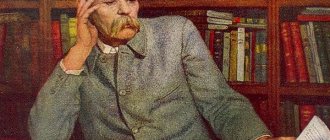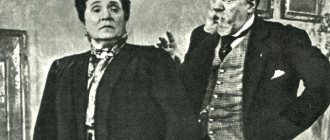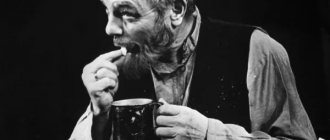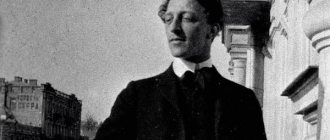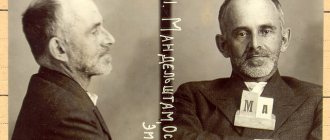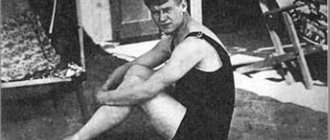A special place in literature, culture and journalism of the Soviet period belongs to Maxim Gorky. Chronological tables will help to better understand the evolution of the writer’s work, which had a powerful influence both on the development of proletarian prose and on socialist art and socio-political life of the early twentieth century. The talent of the singer of the new genre was recognized not only in the USSR, but throughout the world.
Childhood and youth
Maxim Gorky, whose real name was Alexey Peshkov, was born in Nizhny Novgorod on March 16, 1868 into a bourgeois family . The father died when the boy was three years old, and during the same period the child fell ill with cholera. He was treated by his grandfather, a demoted tsarist officer who had returned from exile in Siberia, where he served a sentence for cruel treatment of soldiers. While nursing Alyosha, he became infected and died. The future writer ended up in the family of Vasily Kashirin, his maternal grandfather, the owner of a dyeing workshop and a former deputy of the Nizhny Novgorod Duma.
The boy's childhood was difficult, since his grandfather's methods of education were very rough and inconsistent. In the story “Childhood,” M. Gorky then describes the years of difficult adolescence, filled with hard work and humiliation.
In the Kashirin family, Alyosha was taught to read and write and instilled a love for folk poetry, but further education was out of the question, since his grandfather gave the child “to the people” so that he could support himself independently.
When Alexey turned 15 years old, he entered the Sloboda school, but could not stay on course. A year later, he attempted to take the exams at Kazan University, but failed. From that time on, a period of wandering and vagrancy began in his life, which lasted until 1892, when, after an unsuccessful attempt to commit suicide, he wrote his first story, “Makar Chudra,” published in the newspaper “Caucasus.” The young man did not refuse any work, he was:
- assistant in a shoe store;
- a dishwasher on a Volga steamship;
- as an extra in a fair theater;
- workers in the Caspian fisheries;
- bakery assistant;
- revolutionary propagandist;
- watchman at the railway station.
The writer will say about this period of time: “The more difficult the living conditions were, the stronger and even smarter I felt.” Below is a chronological table with Gorky’s biography by dates until 1893 .
| Year | Event |
| March 16, 1868 | Birth in Nizhny Novgorod |
| 1876—1883 | Ilyinsky School. Completion of two classes |
| 1879 | Death of mother. Getting into the public eye |
| 1884 | Moving to Kazan. Failure in the exam at Kazan University |
| 1887 | Failed suicide attempt |
| 1888—1891 | Wandering around the Volga region, Bessarabia, Ukraine and the Caucasus |
| 1892 | Revolutionary populism. Work on the railway in Tiflis. The story "Makar Chudra". Return to Nizhny Novgorod |
Chronology of the life and work of Maxim Gorky
1868 - Alexey Peshkov was born in Nizhny Novgorod in the family of a carpenter - Maxim Savvatyevich Peshkov.
1884 – tried to enter Kazan University. Gets acquainted with Marxist literature and propaganda work.
1888 – arrested for connections with N.E. Fedoseev’s circle. Is under constant police surveillance. In October he became a watchman at the Dobrinka station of the Gryaze-Tsaritsyn Railway. Impressions from his stay in Dobrinka will serve as the basis for the autobiographical story “The Watchman” and the story “Boredom for the Sake.”
1889, January - at personal request (complaint in verse), transferred to Borisoglebsk station, then as a weighmaster to Krutaya station.
1891, spring - went to wander around the country and reached the Caucasus.
1892 – first appeared in print with the story “Makar Chudra”. Returning to Nizhny Novgorod, he publishes reviews and feuilletons in Volzhsky Vestnik, Samara Gazeta, Nizhny Novgorod Listok, etc.
1897 - “Former People”, “The Orlov Spouses”, “Malva”, “Konovalov”.
1897, October - mid-January 1898 - lives in the village of Kamenka (now the city of Kuvshinovo, Tver region) in the apartment of his friend N.Z. Vasiliev, who worked at the Kamensk paper factory and led an illegal workers' Marxist circle. Life impressions of this period served as material for the novel “The Life of Klim Samgin.”
1898 – the publishing house of Dorovatsky and A.P. Charushnikov releases the first volume of Gorky’s works “Essays and Stories” in a circulation of 3,000 copies.
1899 - novel “Foma Gordeev”.
1900–1901 – novel “Three”, personal acquaintance with Chekhov, Tolstoy.
1900–1913 – participates in the work of the publishing house “Znanie”.
1901, March - “Song of the Petrel” was created in Nizhny Novgorod. Participation in Marxist workers' circles in Nizhny Novgorod, Sormovo, St. Petersburg, wrote a proclamation calling for the fight against autocracy. Arrested and expelled from Nizhny Novgorod. Turns to dramaturgy. Creates the play "The Bourgeois".
1902 - play “At the Bottom”. Elected an honorary member of the Imperial Academy of Sciences. But before Gorky could exercise his new rights, his election was annulled by the government because the writer was “under police surveillance.”
1904–1905 - plays “Summer Residents”, “Children of the Sun”, “Barbarians”. Meeting Lenin. He was arrested for a revolutionary proclamation in connection with the execution on January 9, but then released under public pressure. Participant in the revolution of 1905-1907 In the fall of 1905, he joined the Russian Social Democratic Labor Party.
1906 – travels abroad, creates satirical pamphlets about the “bourgeois” culture of France and the USA (“My Interviews”, “In America”). The play "Enemies", the novel "Mother". Due to tuberculosis, Gorky settled in Italy on the island of Capri, where he lived for 7 years.
1907 - Delegate to the V Congress of the RSDLP.
1908 - play “The Last”, story “The Life of an Useless Person”.
1909 - stories “The Town of Okurov”, “The Life of Matvey Kozhemyakin”.
First publications
In 1895, M. Gorky moved to Samara, where he truly began to study prose and immersed himself in creativity. Alexey Maksimovich published feuilletons and talented notes under the pseudonym Yehudi Chlamida. In the magazine “Russian Wealth”, with the assistance of the writer V.G. Korolenko, he managed to publish the story “Chelkash” about the smuggler Grishka. This work, which received a wide response from critics, opens the way to great literature.
By 1898, the aspiring writer published “Essays and Stories” in two volumes, and then presented readers with the novel “Foma Gordeev,” which made him overnight the most famous and fashionable prose writer among the working class and commoners. The theme of the decomposition and decay of the bourgeoisie, with a direct hint at the inevitability of a change in the political system, made the work extremely popular in the circles of the first wave of revolutionaries.
In April 1901, Gorky was under arrest and charged with sabotaging Narodnaya Volya propaganda directed against the existing order. Thanks to the intercession of L. N. Tolstoy, I. A. Bunin and A. P. Chekhov - authorities who saw Alexei Maksimovich as a great writer and appreciated his literary gift - the authorities had to give up and abandon their claims against the prose writer, releasing him under house arrest arrest.
In the same year he made his debut in drama, and Gorky brought great success to “The Bourgeois”. Then came the plays:
- "At the bottom";
- "Summer Residents";
- "Children of the Sun";
- "Barbarians".
They were included in the repertoire of the Moscow Art Theater and were enthusiastically received by the public and critics. Chronological table of Gorky's life and work in 1895-1905. will help you remember the main events in the life of a prose writer.
| Year | Event |
| 1895 | Moving to Samara. Stories “Chelkash”, “Old Woman Izergil”. “Song of the Falcon” - an allegorical hymn of the revolution |
| 1898—1899 | Meeting A.P. Chekhov in Crimea. Novels "Foma Gordeev" and "Three". Reader recognition. Joining Teleshov's circle. Meeting with L. N. Tolstoy in Moscow |
| 1901 | Arrest for revolutionary propaganda in St. Petersburg. Debut and success in drama. The play "The Bourgeois". “Song of the Petrel” - a prose poem, propaganda for the overthrow of the tsarist regime |
| 1902—1904 | Nizhny Novgorod. Work on plays, the most famous of which was “At the Depths” |
First Russian Revolution
At the end of 1904, Gorky wrote another play - “Children of the Sun”. It talked about a cholera epidemic. However, the authorities considered that the content of this work was completely different and too clearly related to modern events. For this, the author was arrested and ended up in the Peter and Paul Fortress. At the same time, he met actress Maria Andreeva.
Their views on many issues coincided, and Maria became the writer’s faithful companion for a decade and a half. Rice. 6. Gorky’s actual wife, Moscow Art Theater actress Maria Andreeva Gorky’s books and plays were very successful and brought in a good income. By the beginning of the First Russian Revolution, he was no longer a beggar. He became one of those who systematically gave money to the Bolsheviks. However, Gorky also financed some events of other parties. “Bloody Sunday” made a difficult impression on the writer. He became convinced that the political system in Russia needed to be changed. At the end of 1905, he found himself in Moscow, and it was in his apartment that the conspirators—participants in the December uprising—gathered. When the uprising ended, Gorky again headed to the capital. And again, his apartment became the center of events - it was with him that the Central Committee of the Russian Social Democratic Labor Party (RSDLP) met in March 1906. The Bolsheviks agreed to temporarily stop armed uprisings. Such activity could not go unnoticed. Gorky could easily end up in the Peter and Paul Fortress again, so he decided to disappear for a while. To begin with, the writer went to the Grand Duchy of Finland, which was formally part of Russia, but had the rights of broad autonomy and its own laws. He hid there for some time, then he went to Europe, and then visited the States. The writer not only went sightseeing, he also had a more interesting task - to raise money for the party. In America he was received well. He met Mark Twain. Among those he managed to meet was Theodore Roosevelt. But Gorky openly supported the American trade union leaders, and for this the local press very quickly fell out of love with him. The Americans also did not like the too frivolous behavior of the Russian guest - he came to the States with Andreeva, and not with his legal wife. In creative terms, the trip also turned out to be fruitful. The first chapters of the novel “Mother” took shape on this journey. He published the book in Russia two years later, and Lenin praised it very highly.
Rice. 7. Villa in Capri (burgundy), which Gorky rented in 1909 - 1911.
Revolutionary period
In 1905, the first political upheavals occurred in Russia. M. Gorky took part in the demonstration on January 9 (Bloody Sunday) and saw with his own eyes the execution of workers who tried to speak out in defense of their rights. This event greatly influenced the writer, who finally became convinced of the need for social change and the overthrow of the autocracy.
He joined the RSDLP and actively began donating money for the publication of Bolshevik newspapers, and also composed an appeal “To all Russian citizens and the public opinion of European states,” where he openly asked to fight tsarism.
For revolutionary agitation and plans, Alexei Maksimovich was arrested and imprisoned in the Peter and Paul Fortress, and a month later, under public pressure, he was released on bail. This time, not only representatives of the Russian cultural elite, but also progressive European circles that support the ideas of socialism came to his defense.
In the same year, he met V.I. Lenin, who played a key role in the subsequent life and work of the writer. 12 years later, after the February Revolution, which Gorky criticized in his own newspaper “Novaya Zhizn”, the head of the Bolshevik Party persuaded him to go into exile and engage in communist propaganda activities abroad, since the leader of the proletarians could not allow the loss of the “cultural icon” of the working class. The discord with the socialist movement and the change in attitude towards the revolution can be briefly characterized by the following statements of the writer:
- “Lenin, Trotsky and those accompanying them have already been poisoned by the rotten poison of power. Blind fanatics and unscrupulous adventurers are allegedly rushing along the path of social revolution.”
- “The right to dishonor is the easiest way to entice a Russian person to follow him, and so they coldly dishonor the revolution and the working class, forcing it to carry out bloody massacres.”
In 1918, Gorky founded the publishing house “World Literature” and began working actively there, while simultaneously trying to save the Russian intelligentsia from executions and terror. He spared no capital and effort for these humanistic goals. However, by 1921 he himself was under threat of arrest, so he decided to emigrate to Europe. After the death of V.I. Lenin, he began work on the detailed epic “The Life of Klim Samgin,” which became the pinnacle of his creativity and the comprehension of his writing path.
Singer of the Revolution
In 1901, “Song of the Petrel” appeared, in which Gorky very briefly and accurately reflected the state of mind. Russia needed transformations, and it was already clear that they could not be achieved peacefully. Sometimes this work is perceived as a call for rebellion, although in fact it is not. Gorky simply caught the mood. However, he also participated in political activities at this time - he attended classes in Marxist circles, even helped write leaflets. For this he was once again arrested and banned from appearing in Nizhny Novgorod.
Rice. 5. M. Gorky, D. N. Mamin-Sibiryak, N. D. Teleshov and I. A. Bunin. Yalta. 1902 The writer was greatly influenced by his acquaintance with Lenin. This happened in 1902. They quickly found a common language and even became friends. Gorky earned the respect of many members of the intelligentsia when he exposed the provocateur Matvey Golovinsky.
Important! In the same year, Gorky was proposed to be elected a member of the Imperial Academy. A scandal broke out and the election results were annulled. In response to this, others also left the Academy - in particular, Korolenko and Chekhov.
Return to Russia
The decision to return to the USSR became the final biographical page for the prose writer. The period from 1933 to influenza and death in 1936 was a time of extensive social work and a kind of culmination of the entire career of M. Gorky, who became the chairman of the new All-Union Congress of Soviet Writers.
At this stage, he worked only on the history of Klim Samgin and dealt with the problems of Soviet literature, met with popular European writers R. Rolland and G. Wales, as well as with the leaders of the USSR party elite Stalin and Molotov, who had to reckon with the opinion of this “cultural block” . Below is a table with a brief chronology of the main events of the biography of 1905-1936.
| Period in years | Fact |
| 1905 | Participation in the first Russian revolution. Arrest |
| 1906 | Emigration to America. Death of a daughter. Moving to Italy on the island. Capri |
| 1907 | Meeting V.I. Lenin in London and A.V. Lunacharsky. Novel "Mother" |
| 1909 | Organization of a party school in Capri. The stories “Summer” and “Okurov Town” |
| 1910 | Plays “Vassa Zheleznova” and “Weirdos” |
| 1911—1912 | Work in the editorial office of the Sovremennik magazine. The cycles “Tales of Italy”, “Across Rus'” and “Russian Tales” |
| 1913—1914 | Moving to Finland. The stories “Childhood”, “The Master” and “In People” |
| 1915—1916 | Founding of the Parus publishing house, work in Moscow and St. Petersburg, editing the Chronicle magazine. Receiving the title of honorary academician |
| 1917—1920 | Denial and criticism of the revolution. Founding of the newspaper “New Life” and the publishing house “World Literature”. Active correspondence with V.I. Lenin |
| 1921—1933 | Emigration to Europe. Life in Sorrento. Visit to the USSR. The novel “The Artamonov Case” and the beginning of work on the epic “The Life of Klim Samgin” |
| 1933—1935 | Return to Moscow. Death of son Maxim. Chairmanship of the All-Union Congress of Writers, active social work |
| June 18, 1936 | Death from pneumonia. Buried in Moscow near the Kremlin wall |
The writer left a rich literary heritage. Among the main works of M. Gorky one can note:
- Novels “Foma Gordeev”, “Mother”, “The Artamonov Case”, “The Life of Klim Samgin”.
- The stories “Childhood”, “Summer”, “Okurov Town”.
- Plays “Philistines”, “At the Depths”, “Vassa Zheleznova”, “Children of the Sun”, “Enemies”.
- Stories “Makar Chudra”, “Old Woman Izergil”, “Chelkash”.
- Prose poems “Song of the Falcon”, “Song of the Petrel”.
Maxim Gorky became one of the most significant figures in Soviet literature; he had to hone his skills during a turning point.
A brief chronological analysis of the prose writer’s writing career allows us to see the evolution and comprehend the fundamental problems of his work.
Chronological table of Pushkin Alexander Sergeevich
1868
- Birth of Alexei Peshkov, in the future - Maxim Gorky. The boy grew up in a poor middle-class family, whose father was engaged in carpentry.
1884
— Peshkov enters Kazan University, but fails.
1884
— He becomes close to radical youth. He studies the theory of Marxism and calls for the fight against autocracy.
1887
— Peshkov tries to shoot himself, but the suicide attempt fails. He recovers, but the shot lung will become a weak link in his body.
1888
— The future writer was taken under arrest for connections with Fedoseev’s organization.
Late 1880s – early 1890s
— Peshkov travels around Russia, he visited Ukraine, the Caucasus, and Crimea. This same period can be considered the beginning of literary activity. Peshkov publishes his first stories.
Since 1889
— He was arrested several times for revolutionary agitation.
1891
— The period of wanderings around Russia.
1892
— By this time, Peshkov had already changed many professions. He was a carpenter, a dyer, a baker, a loader, a barge hauler, a watchman, and a reporter.
1892
— Appearance of the story “Makar Chudra” in print. It was published by the Tiflis newspaper “Caucasus”. The aspiring writer signs this story with the pseudonym Maxim Gorky.
1894
- Publication of the story “Chelkash”.
1895
— Publication of the story “Old Woman Izergil”, poem “Song of the Falcon”.
1896
— The writer marries Katya Volzhina.
1896
- Gorky fell ill. After suffering from bronchitis, he develops pneumonia and is eventually diagnosed with tuberculosis. This illness will accompany him throughout his life.
1897
— Publication of the story “Konovalov.”
1897
— The couple has a son, Maxim.
1898
— After the publication of the two-volume book “Essays and Stories,” Gorky became a writer with all-Russian fame. In the near future, Western Europe will learn about it.
1899
— Arrival in St. Petersburg and Moscow, where the writer meets representatives of the revolutionary-minded intelligentsia. During these years, he invested money earned from the books he sold into the fight against the autocracy. These funds, in particular, are used to hire lawyers to defend prisoners who protested the existing system. He financially supports the newspaper “Forward”, founded by Lenin.
1900
— The writer’s acquaintance with Leo Tolstoy.
1901
- Gorky was arrested and sent to Nizhny Novgorod prison. Here he writes “The Song of the Petrel” - a poem that inspires heroic deeds and calls for tireless struggle.
1901
- Visits Marxist organizations and circles in different cities - Sormovo, Nizhny Novgorod, St. Petersburg.
1901
— Heads the publishing house “Znanie”.
1901
— In connection with revolutionary propaganda, Gorky was arrested and expelled from his hometown.
1901
— Participates in a demonstration in St. Petersburg near the Kazan Cathedral.
1902
— The writer was appointed honorary academician of the Academy of Sciences in the category of fine literature, but this appointment will soon be cancelled. Korolenko and Chekhov, who renounced their own academician titles, expressed protest against Gorky’s resignation from the Academy.
1902
— Writing the play “At the Bottom.”
1902 — 1921
- Head of 3 well-known publishing houses - “Parus”, “World Literature”, “Knowledge”.
1905
— Meeting with Lenin.
1905
— He took part in a demonstration, the participants of which were severely punished. This massacre caused a wave of indignation. Having become a member of the Social Democratic Party, Gorky calls for struggle and supplies workers with weapons for street fighting. The writer was arrested and imprisoned in the Peter and Paul Fortress, but released under public pressure.
1905
— Issue of the newspaper “New Life”.
1905-1907
- Financial assistance to the revolution.
1906
— Gorky’s speech during a rally in Helsingfors.
1906
— Departure for the USA in order to hide from the authorities and raise funds for the revolutionary struggle. That same year, fearing new persecution, the writer left the United States.
1906
— Writing the novel “Mother”, the play “Enemies”.
1906 — 1913
— Moving to Italy to Capri due to the need to leave the USA and the exacerbation of the disease.
1911 — 1917
— The following cycles have been created: “Tales of Italy”, “Russian Fairy Tales”, “Across Rus'”.
1913
— In connection with the amnesty timed to coincide with the anniversary of the Romanov dynasty, the writer returned to his homeland.
1913
— Editing the newspapers “Pravda” and “Zvezda”, published by the Bolsheviks.
1913 — 1923
— Writing the famous trilogy “Childhood”, “In People”, “My Universities”.
1914
— Gorky moves to Finland.
1915
— Manages the journal “Chronicle”.
1917 — 1918
— Publication of the newspaper “New Life”.
1917
— Expresses a sharply negative attitude towards the revolution of 1917, has conflicting relations with Lenin, despite many years of support for the revolutionary movement. Despite the rejection of the new government, the writer will give a lot of effort to restore cultural life in the USSR.
1918 — 1919
— Engaged in political and social work, condemns the methods of the Bolsheviks.
1921 — 1928
— Moving to Italy due to an exacerbation of tuberculosis, according to the official version.
1927 — 1936
— Writing the novels “The Artamonov Case”, “The Life of Klim Samgin”.
1931
— The writer returns to the Soviet Union. He is a leading writer and supports Stalin's activities.
Since 1931
— Engaged in social activities, preparing young writers, one of the founders of the Writers’ Union, and later its leader, writes new works, publishes magazines and newspapers.
1933
- Gorky is moving to the capital.
1936
— The writer died. The urn with the ashes is located in the Kremlin wall.
